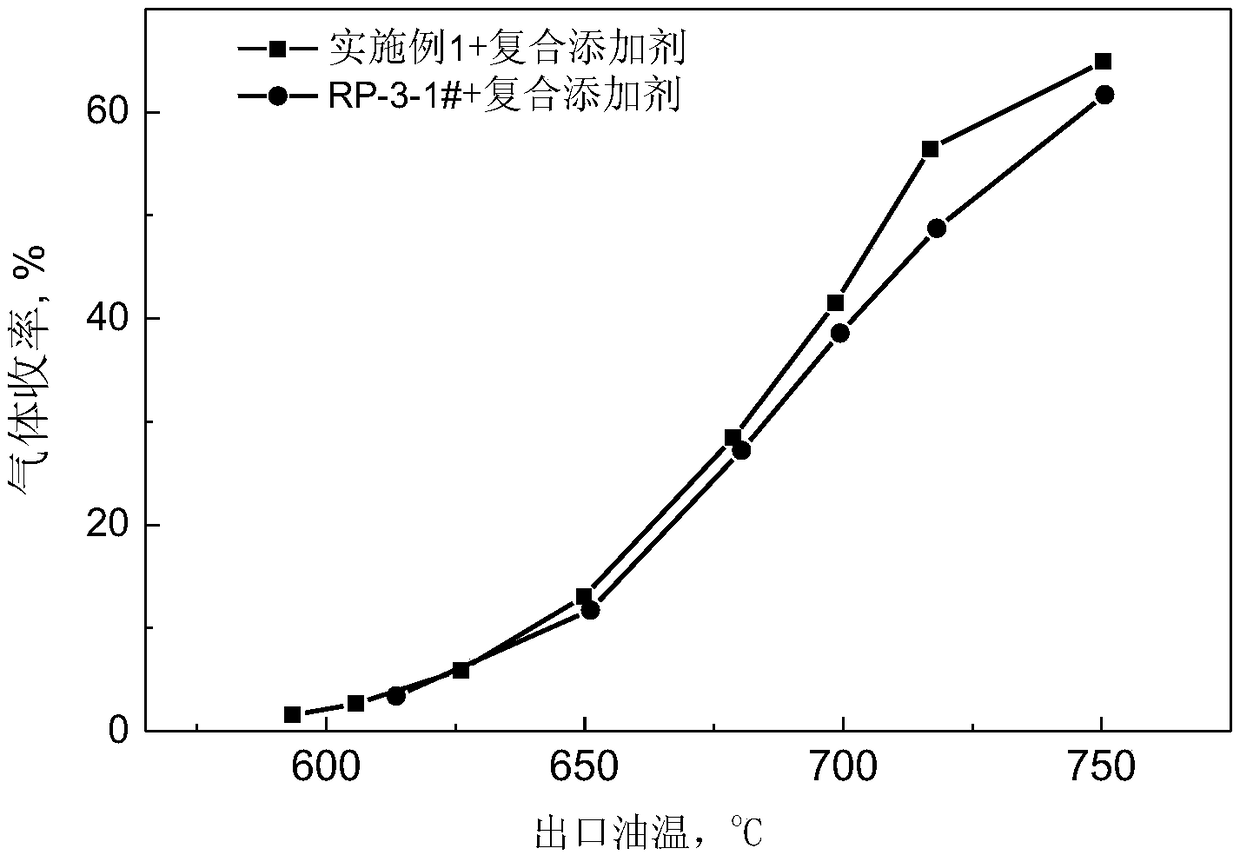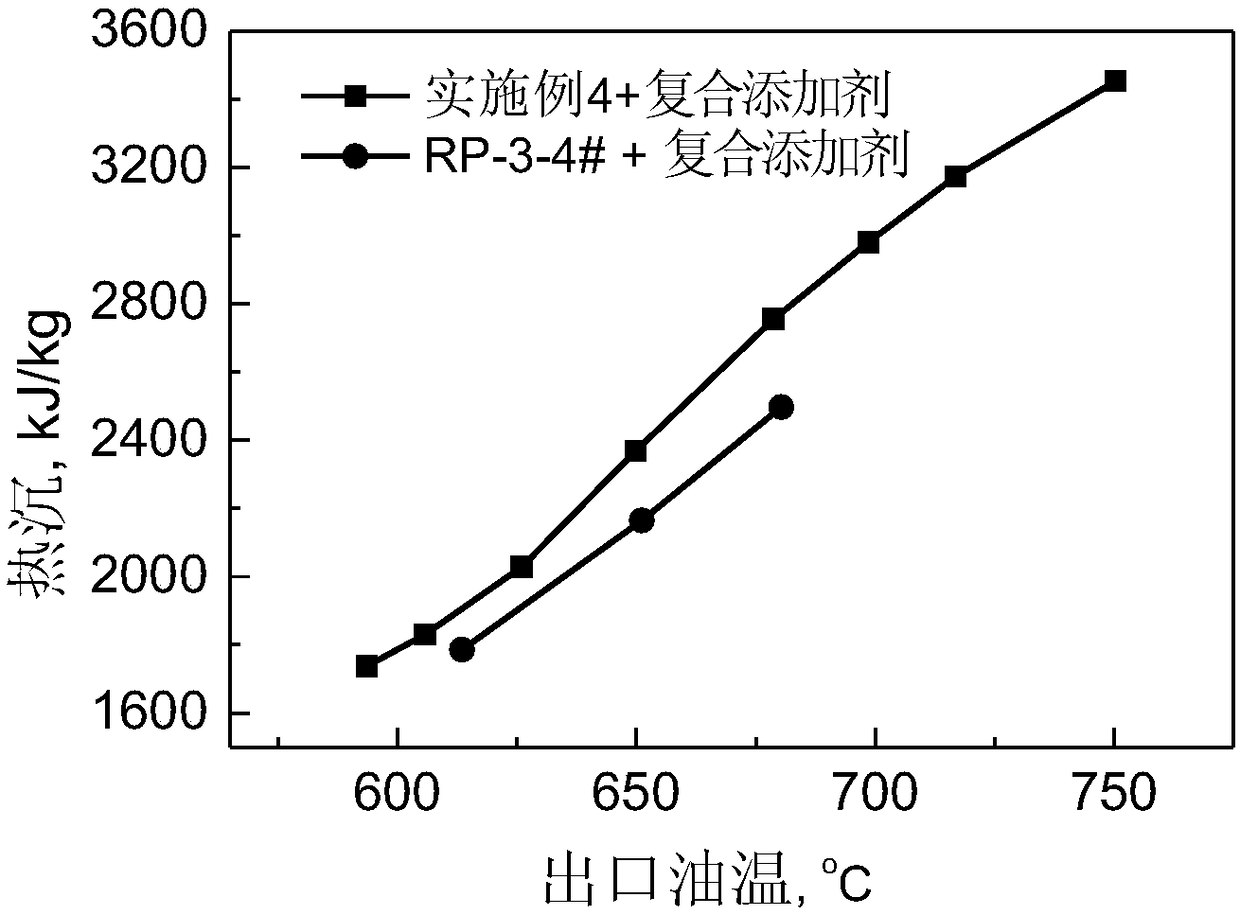Endothermic aviation fuel and preparation method thereof
A kind of aviation fuel and fuel technology, applied in the chemical field, can solve the problems of low heat sink value of fuel, incompatibility of fuel heat sink value and anti-coking performance, easy coking of fuel, etc., to achieve high heat sink value, improved performance, good Effect of anti-coking properties
- Summary
- Abstract
- Description
- Claims
- Application Information
AI Technical Summary
Problems solved by technology
Method used
Image
Examples
Embodiment 1
[0035] Aviation fuel was prepared from RP-3-1# jet fuel.
[0036] hydrogenation reaction
[0037] RP-3-1# jet fuel was subjected to hydrogenation saturation treatment with a commercially available hydrorefining catalyst (FH-98): hydrogen partial pressure 6MPa, hydrogen-to-oil ratio (volume) 500, space velocity 1.0h-1, temperature 280 °C, the hydrogenation treatment makes the bromine value of the obtained fuel sample less than 0.2gBr / 100g, and the aromatic hydrocarbon content is not more than 2wt%.
[0038] Distillation separation
[0039] Carry out rectification under reduced pressure (vacuum degree-94.6kPa) to the fuel sample obtained by hydrogenation saturation treatment, collect the distillate that actual distillation range is more than or equal to 180 ℃, namely obtain the aviation fuel of high thermal stability (embodiment 1 product), performance test The results are shown in Table 2.
Embodiment 2
[0041] Aviation fuel was prepared from RP-3-2# jet fuel.
[0042] Hydrogenated Saturation:
[0043] Hydrogenation saturation treatment of RP-3-2# jet fuel was carried out with a commercially available hydrorefining catalyst (FH-98): hydrogen partial pressure 6MPa, hydrogen-to-oil ratio (volume) 500, space velocity 1.0h -1 , the temperature is 300-315° C., and the hydrogenation saturation treatment makes the aromatic hydrocarbon content of the obtained fuel sample not more than 3%.
[0044] Distillation separation
[0045] The fuel sample obtained by hydrosaturation treatment was subjected to vacuum rectification, and the fraction whose actual distillation range was above 175° C. was collected to obtain high thermal stability aviation fuel (the product of Example 2). The performance test results are shown in Table 2.
Embodiment 3
[0047] Aviation fuel is prepared from RP-3-3# jet fuel.
[0048] hydrogenation reaction
[0049] RP-3-3# jet fuel was subjected to hydrogenation saturation treatment with a commercially available hydrotreating catalyst (FH-98): hydrogen partial pressure 6MPa, hydrogen-to-oil ratio (volume) 500, space velocity 0.5h -1 . The temperature is 310-315° C., and the hydrogenation saturation treatment makes the aromatic content of the obtained fuel sample not greater than 4%, and the sulfur content not greater than 5ppm.
[0050] Distillation separation
[0051] The fuel sample obtained by hydrosaturation treatment was subjected to vacuum rectification, and the fraction whose actual distillation range was above 175° C. was collected to obtain high thermal stability aviation fuel (the product of Example 3). The performance test results are shown in Table 2.
PUM
| Property | Measurement | Unit |
|---|---|---|
| Flash point | aaaaa | aaaaa |
Abstract
Description
Claims
Application Information
 Login to View More
Login to View More - R&D
- Intellectual Property
- Life Sciences
- Materials
- Tech Scout
- Unparalleled Data Quality
- Higher Quality Content
- 60% Fewer Hallucinations
Browse by: Latest US Patents, China's latest patents, Technical Efficacy Thesaurus, Application Domain, Technology Topic, Popular Technical Reports.
© 2025 PatSnap. All rights reserved.Legal|Privacy policy|Modern Slavery Act Transparency Statement|Sitemap|About US| Contact US: help@patsnap.com



